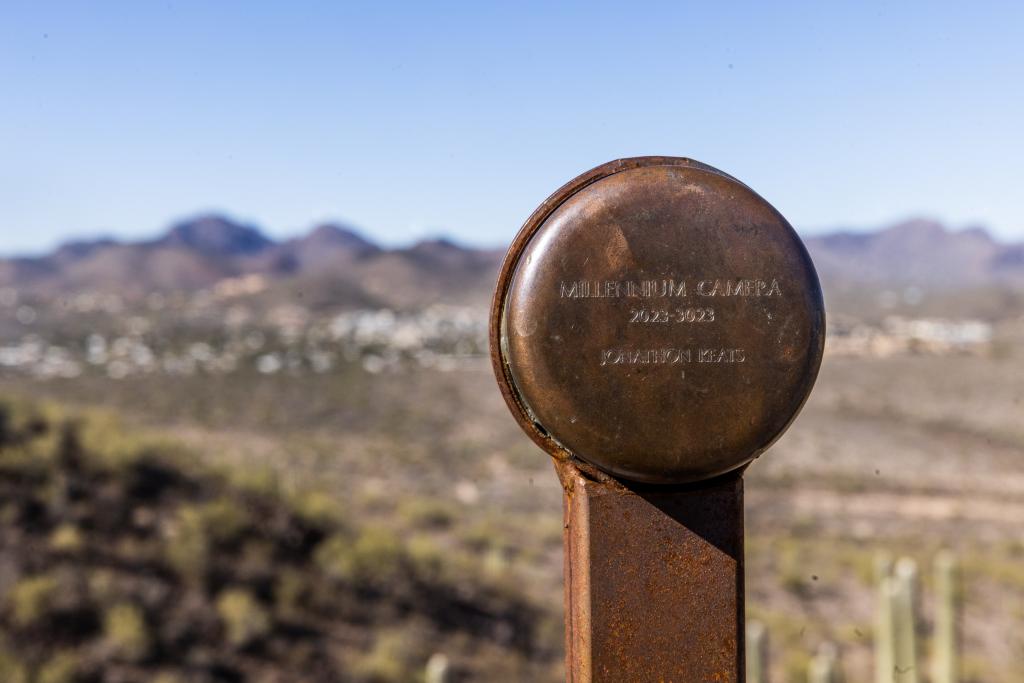You can’t do a time lapse like this on your iPhone.
A University of Arizona professor hopes to capture the changing landscape of Tucson over the next thousand years, setting up a primitive pinhole camera for extremely long exposures that will be ready for viewing in 3023.
Jonathon Keats, 52, has mounted his Millennium Camera on a steel pole overlooking a desert area that is the site of a new housing development in the foreground of a mountain range.
The research fellow at the university’s school of fine arts said he hoped his photography project would serve as a “philosophical tool” that would make people consider “man’s profound impact on our environment” over the coming millennia.
“Whatever happened in that time period is captured in an image that will ideally be visible … to them in the future,” Keats said, adding that he hoped the project would also encourage present-day considerations of “hyper-urbanism.”
“Say cheese… for a thousand years!” The Millennium Camera was set up next to a bench in Starr Pass, Tucson. C. Richards/Univ. Comms/SWNS
“It’s equally aimed at us in the present and through time … because we might be tempted to change the picture to make it the way we want them to see it.”
Long-exposure pinhole cameras are known as early as 500 BC, according to researchers.
Keats went back to basics and used ancient technology for his project because, “nobody will remember to change the battery after 300 years if you have a digital camera [and] in 1,000 years people may not know how to develop physical pictures.”
A low-tech camera focuses sunlight through a pinhole and projects it onto film on the back of the camera, where an impression of the landscape is slowly created over time.
Keats used a pinhole camera for the project, using technology that has been around for more than a millennium. Sibyl Savage
Keats used renaissance oil painting techniques for his canvases: a pigment called red madder was painted on copper that had been rubbed with pumice stone and garlic to create a photo-sensitive surface that would “gradually fade.”
The pinhole is pierced through 24-karat gold, which “won’t corrode,” according to the professor.
The resulting images must be “time capsules” and “also portals through time” that “require interpretation,” he told The Post.
For example, a thousand-year exposure of Manhattan, starting in 1024 and seen today, would only faintly display its most famous skyscrapers, which have only existed for a century or so.
If the development of a major city sprouts in 500 years, “you will see the ghost of the skyscraper but it will not be an opaque image like the mountain that was there” for the duration of the photo shoot,” explained Keats. .
The camera has been mounted on a steel pole and has already started recording its epic time-lapse. C. Richards/Univ. Comms/SWNS
“Or if all the existing buildings were to be moved, you would see them as ghosts,” he said, adding that “the gradual movement would be blurred, like sports photography.”
Of course anything can happen in 1,000 years. Humans may become extinct. The area could be flattened by an asteroid or natural disaster. Alien invaders may make Tucson their Earth capital.
At the very least, the plaque marking the project had to be replaced several times over the centuries.
Keats is also working on installing other millennial cameras in Los Angeles, the Austrian Alps and Chongqing, China
“A lot of things can happen and I think no matter what happens, it’s the image of the world and how the world is changing,” said the innovator.
“What is most likely to happen is that we will be surprised.”
So, hold that pose Tucson. It will be a moment.
Categories: Trending
Source: thtrangdai.edu.vn/en/



